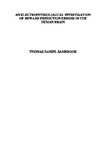AN ELECTROPHYSIOLOGICAL INVESTIGATION OF REWARD PREDICTION ERRORS IN THE HUMAN BRAIN
| dc.contributor.supervisor | Goslin, Jeremy | |
| dc.contributor.author | Sambrook, Thomas | |
| dc.contributor.other | School of Psychology | en_US |
| dc.date.accessioned | 2015-07-28T09:02:12Z | |
| dc.date.available | 2015-07-28T09:02:12Z | |
| dc.date.issued | 2015 | |
| dc.identifier | 10325359 | en_US |
| dc.identifier.uri | http://hdl.handle.net/10026.1/3462 | |
| dc.description.abstract |
Reward prediction errors are quantitative signed terms that express the difference between the value of an obtained outcome and the expected value that was placed on it prior to its receipt. Positive reward prediction errors constitute reward, negative reward prediction errors constitute punishment. Reward prediction errors have been shown to be powerful drivers of reinforcement learning in formal models and there is thus a strong reason to believe they are used in the brain. Isolating such neural signals stands to help elucidate how reinforcement learning is implemented in the brain, and may ultimately shed light on individual differences, psychopathologies of reward such as addiction and depression, and the apparently non-normative behaviour under risk described by behavioural economics. In the present thesis, I used the event related potential technique to isolate and study electrophysiological components whose behaviour resembled reward prediction errors. I demonstrated that a candidate component, “feedback related negativity”, occurring 250 to 350 ms after receipt of reward or punishment, showed such behaviour. A meta-analysis of the existing literature on this component, using a novel technique of “great grand averaging”, supported this view. The component showed marked asymmetries however, being more responsive to reward than punishment and more responsive to appetitive rather than aversive outcomes. I also used novel data-driven techniques to examine activity outside the temporal interval associated with the feedback related negativity. This revealed a later component responding solely to punishments incurred in a Pavlovian learning task. It also revealed numerous salience-encoding components which were sensitive to a prediction error’s size but not its sign. | en_US |
| dc.language.iso | en | en_US |
| dc.publisher | Plymouth University | en_US |
| dc.subject | Event related potential | en_US |
| dc.subject | ERP | en_US |
| dc.subject | Feedback related negativity | en_US |
| dc.subject | FRN | en_US |
| dc.subject | Reward prediction error | en_US |
| dc.subject | Unsigned prediction error | en_US |
| dc.subject | Dopamine | en_US |
| dc.subject | Prospect theory | en_US |
| dc.subject | Meta-analysis | en_US |
| dc.subject | Great grand average | en_US |
| dc.subject | Reinforcement learning | en_US |
| dc.title | AN ELECTROPHYSIOLOGICAL INVESTIGATION OF REWARD PREDICTION ERRORS IN THE HUMAN BRAIN | en_US |
| dc.type | Thesis | en_US |
| plymouth.version | Full version | en_US |
| dc.identifier.doi | http://dx.doi.org/10.24382/1340 | |
| dc.identifier.doi | http://dx.doi.org/10.24382/1340 |
Files in this item
This item appears in the following Collection(s)
-
01 Research Theses Main Collection
Research Theses Main


